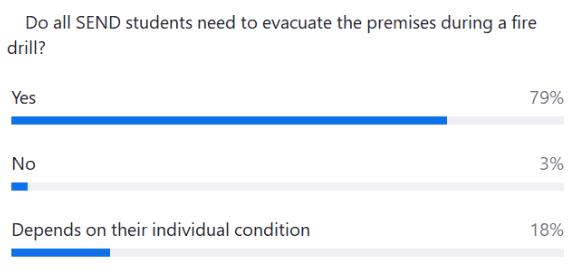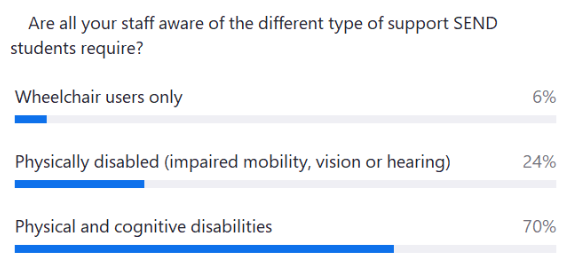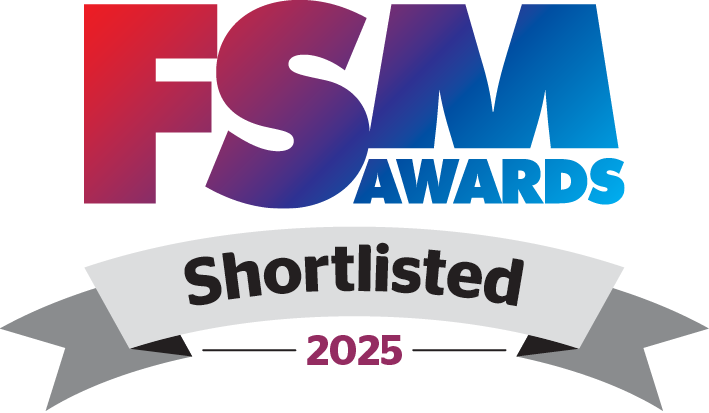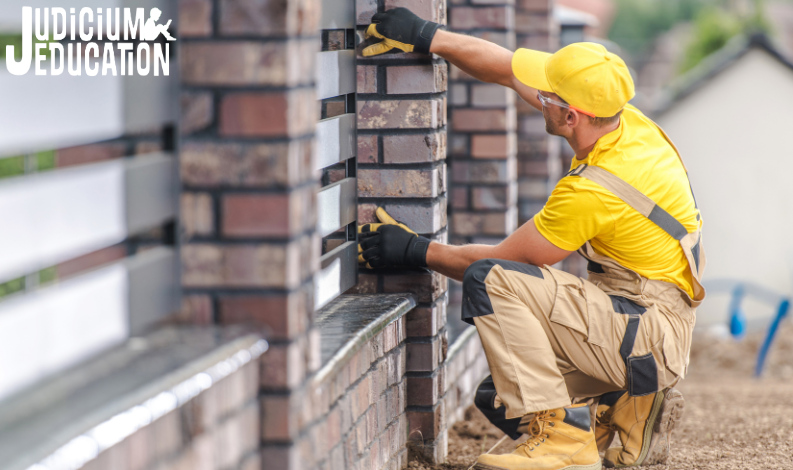Fire Safety Management: Supporting SEND Students
_1000.png)
This blog is based on Judicium’s Health and Safety ‘Sofa Session’ from the 23rd October, with our resident expert Andy Camroux MSc CertIOSH. This session focused on Personalised Emergency Evacuation Plans (PEEPs) for SEND students, risk assessments, accessible safety measures, which may include using visual alarms, tactile signage, and accessible exits and staff training and support, including understanding how to use specialised equipment like evacuation chairs and how to communicate effectively with students who have specific needs.
Poll 1

Personalised Emergency Evacuation Plans (PEEPs) for SEND students
A PEEP is a document that outlines how people who may need assistance evacuating a building in an emergency can be safely and quickly evacuated. A PEEP is required when somebody cannot follow the ‘normal’ evacuation plan. PEEPs may be permanent or temporary, depending on the individual’s condition.
The PEEP should cover specific responsibilities, i.e. those responsible for managing the premises and those responsible for managing the person who requires a PEEP. All persons with responsibilities during evacuations need to be aware of the evacuation procedure, which includes how the alarm is raised, getting a person to a safe place and reducing unnecessary escapes.
The PEEP should confirm who is required to provide assistance and what methods of assistance may be provided. Finally, the PEEP should confirm who is responsible for implementing, approving and monitoring the PEEP. Monitoring the PEEP is important as a person needs change as their condition changes and as a check that the PEEP went to plan.
Risk assessments
All employers are required to complete risk assessments of significant risks in their workplace. Ideally, risk assessments should be completed by the persons responsible for the specific area within the school/trust. This approach ensures the person conducting the risk assessment understands the particular risks and hazards associated with their area and can effectively assess them and identify controls to reduce them to an acceptable level. The process of conducting a risk assessment in school involves 5 steps:
- Identify the hazards
- Decide who might be harmed and how
- Evaluate the risks and decide on precautions
- Record your findings and implement them
- Review your assessment and update it if necessary
The main hazards associated with SEND students are impaired mobility, impaired vision, impaired hearing, anxiety, attention or impulsivity and sensory issues such as noise sensitivity.
Other issues include preventing others from leaving room, student activates fire alarm deliberately and physical aggression towards staff or other students.
Accessible safety measures
When most people think of accessible safety measures, the first thing they seem to consider is measures to assist occupants with impaired mobility, e.g. handrails, wheelchairs, lifts (platform, chair or passenger), evacuation chairs/sledges, etc.
But there are many other measures that can be put in place to assist those with other disabilities, including impaired hearing such as, warning beacons, vibrating pads/pagers, email, text messaging, human assistance, e.g. BSL interpreter. As well as measures to assist those with impaired visibility include colour contrast (on steps & ramps), handrails, bespoke escape plans / fire action notices, e.g. braille, large print or tactile maps.
Finally, measures to assist those with cognitive disabilities include colour contrast, video/photos of escape procedure/route, recorded instructions, etc.
Poll 2

Staff training and support
School staff should receive fire safety training that includes how to assist people with disabilities or special educational needs (SEND). This training should include:- Induction training: This should be given on the first day of employment and should include an understanding of the legal requirements for the health and safety of people with SEND.
- Task-specific training: This should be completed by personnel with specific duties:
- SENDCO who needs to oversee the production of PEEPs,
- Fire Wardens who need to be aware of how many PEEPs, details of PEEPs, communication with SEND students, checking hiding places,
- Buddies / Carers – specific assistance requirements (physical and behavioural) and moving, lifting and handling techniques.
- Refresher training: This should be given periodically and as each SEND student’s needs change, e.g. as a medical condition develops.
Key Take Aways
- Not all SEND students require a PEEP. As their name implies, PEEPs are personal. Students' escape plans should be developed as part of the admissions process and be regularly reviewed – if a student without a PEEP struggles during a fire drill, it may be necessary to introduce a PEEP.
- Avoid unnecessary building evacuations. Some disabled people are put at a great risk when carry-down procedures of any kind are used. It is therefore necessary for the evacuation policy to include a method of reducing or removing the need to escape for a false alarm. It is likely that many more disabled people will be willing to facilitate their own escape when they know that this is not going to be required of them during a practice or for a false alarm.
- Develop plans in consultation with staff, students, carers and medical experts and review them based on how well they perform during fire drills or how a student’s condition develops.
Further Information
HM Government (DCLG) Fire safety risk assessment: means of escape for disabled people
Helpful Links:
Judicium Education’s Health and Safety Advisory Service is designed to support schools, firstly, in ensuring a safe working and learning environment, secondly, in complying with the legal requirements imposed on them as employers under the various Health & Safety laws and regulations. For more information, please visit here.
If you require any support in any of these steps, or would like to talk to someone surrounding some support for your school please do not hesitate to call us on 0207 336 8403 or email Georgina.decosta@judicium.com.
The Health and Safety Service is also providing accredited training courses, including eLearning with specific modules ranging from courses designed for premises managers and SLT to all staff offerings and fire warden training: https://www.judiciumeducation.co.uk/elearning
We also offer live, exclusive training options: https://www.judiciumeducation.co.uk/training
To review Judicium’s forthcoming sofa sessions please click here.
Follow us on Twitter - @JudiciumEDU
© This content is the exclusive property of Judicium Education. The works are intended to provide an overview of the sofa session you attend and/or to be a learning aid to assist you and your school. However, any redistribution or reproduction of part or all of the contents in any form is prohibited. You may not, except with our express written permission, distribute or exploit the content. Failure to follow this guidance may result in Judicium either preventing you with access to our sessions and/or follow up content.
Related content

Discover why Judicium has been shortlisted for Fire Safety Consultancy of the Year at the 2025 FSM Awards, recognising our expert support for schools and trusts in delivering sector-specific, compliant, and practical fire safety solutions.
.png)
This blog is based on Judicium’s Health and Safety ‘Sofa Session’ from the 12th of March, with our resident expert Mike Wright.

This blog is based on Judicium’s Health and Safety ‘Sofa Session’ from the 26th of February, with our resident expert Loretta Igbe.

This blog is based on Judicium’s Health and Safety ‘Sofa Session’ from the 8th of January, with our resident expert Jim Liddy.

This blog is based on Judicium’s Health and Safety ‘Sofa Session’ from the 6th of November, with our resident expert Isthar Pearce.

This blog is based on Judicium’s Health and Safety ‘Sofa Session’ from the 16th of October, with our resident expert Rachel Kitchen.


H&S